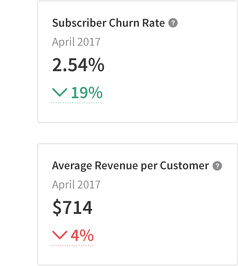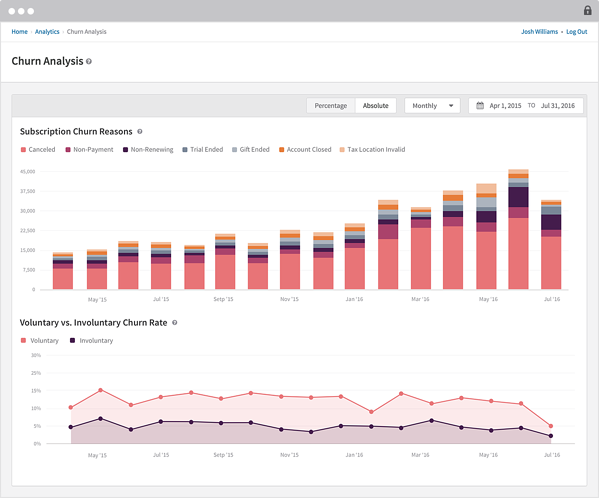Using Recurly Data to Fight Churn

In our previous post in this series, we talked about the difference between cancellation and churn. The post outlined the different actions you can take when a customer cancels to try to prevent them from churning and how Recurly helps to identify these customers.
Because we know you can’t prevent all churn, we want to talk about ways to analyze your subscriber churn rate to surface insights that you can then act upon. In particular:
Where does your churn rate stand in comparison to your competitors and/or to the market as a whole?
What are some of the meaningful data points related to churn that provide actionable intelligence?

Recently, Recurly Research examined a sample of over 1,200 subscription sites over a period of 12 months which provided the following benchmarks for Subscriber Churn Rate. We’ll be releasing the comprehensive information shortly, but our high-level results are shown below. (Review our “Churn Definitions” blog post for a refresher on metrics and their definitions.)
What is the median subscriber churn rate by industry?

What is the median subscriber churn rate, based on average revenue per customer?


To understand where your business stands in comparison to these benchmarks, Recurly customers can view their specific Subscriber Churn rate and Average Revenue per Customer on their Analytics Dashboard.
Now that you know where you stand, how can you take action to reduce churn?
The first step is to break down your overall churn rate into more meaningful numbers. There are several ways to do this.
Method 1: Break out paid subscriber churn from all subscriber churn
Churn that results from users of a free trial of your product/service is very different from churn from paying subscribers. A subscriber who is not paying you is not yet fully committed to using your product or service, and they are not creating subscriber lifetime value. Therefore, you can think of non-paid churn more as a problem of acquisition or conversion strategy than of retention strategy. While both types of churn are important and can provide insights, they should be evaluated separately.
How Recurly can help: Recurly offers several reports on churn and retention that can help our customers break out paid churn from total churn.
Method 2: Utilize a churn cohort analysis
Subscriber Churn as a single number can mask some important details about your subscribers’ churn behavior. A cohort analysis can help to uncover additional insights about churn behavior, such as when subscribers are churning in their lifecycle. It also allows you to continually test different strategies to prevent churn and quickly evaluate the impact to each cohort. This will help you use your resources more efficiently by strategically targeting a certain time frame—i.e. a particular cohort—in the subscriber lifecycle.
To set up a churn cohort analysis, you will want to track the total number of paid sign-ups each month, with each month’s sign-ups representing its own cohort. Then, for each cohort, track the retention and churn rates month over month. If you start to see a pattern of when certain cohorts tend to churn, you can then devise tactics to proactively address these cohorts before the churn occurs.
How Recurly can help: Recurly offers this type of analysis in our our Subscriber Retention report. You can even filter this report by Plan in order to further investigate churn trends.

Method 3: Evaluate different types of churn
There are two main types of churn: voluntary and involuntary churn. The total subscriber churn rate is an aggregate of both types.
Recurly Research found the median voluntary churn rate in our sample was 4.78% and the median involuntary churn rate was 1.32%.
Because voluntary churn indicates an active subscriber’s desire to discontinue paying for your product or service, you will want to address this type churn through efforts that focus on improving customer satisfaction.
Alternatively, involuntary churn is passive and happens through card declines and invoice failures. You will want to mitigate this type of churn with tools that minimize invoice failures and which help to recover revenue, such as dunning and account updater.
As you can see, voluntary and involuntary churn require very different prevention strategies, so it’s important to monitor voluntary and involuntary churn separately to measure the effectiveness of the the strategies you employ.
How Recurly can help: In Recurly’s Churn Analysis report, you’re able to evaluate the seven most common reasons that subscriptions churn, as well as monitor voluntary and involuntary churn rate trends over time.

Method 4: Evaluate WHO is churning and how valuable they are
Your subscribers are a great source of information about how your subscription product or service is viewed and valued. To gain insights:
Talk to subscribers who churned and then returned to your service at a later point to understand why they previously churned and why they chose to return.
Evaluate the characteristics of the subscriptions that churned. Are you seeing more subscriptions churn out of one plan or price point?
Are you churning high-value subscribers? If so, this will eat away at more of your revenue compared to churn from average or low-value subscribers. Your subscriber churn rate alone won’t represent the monetary value of the subscriptions that churned. To understand that, you will want to evaluate churned recurring revenue to see the total recurring revenue lost from churned subscriptions.
How Recurly can help:
Dig into the characteristics of your churned subscriptions using Recurly’s “Churned Subscriptions” export
Understand the value of churned subscriptions by using Recurly’s MRR Growth report, which reports on Churned MRR.
Look to the data for insights
For subscription businesses, success is predicated on long-term subscriber relationships. This means that monitoring your subscriber churn rate is key. High churn decreases the total value of your subscriber relationships. But, your subscriber churn rate is simply a number—it’s not actionable by itself. In order to fight churn in a truly effective way, you need to dig into the data around who churns, why they churn, and when they churn. This is where the insights lie. Recurly provides these data points to our customers, transforming a simple key performance indicator into a truly actionable insight.


